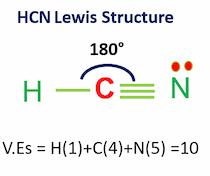Ammonia (NH3) is a colorless, pungent gas and is made up of nitrogen and hydrogen. In the NH3 Lewis structure, three hydrogen atoms are bound to a nitrogen atom. NH3 molecular geometry is trigonal-pyramidal.
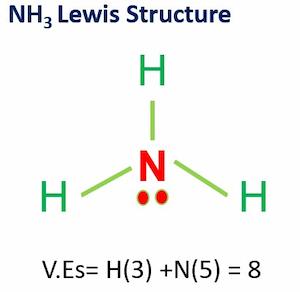
| Name of molecule | Ammonia (NH3) |
| Bond Angles | 107.3 degrees |
| Molecular Geometry of NH3 | Trigonal-Pyramidal |
| Hybridization of NH3 | SP3 hybridization |
| Electronic configuration | 1S22S22P3. |
| NH3 oxidation number | zero |
Table of Contents
NH3 molecular geometry
In ammonia molecular geometry, three hydrogen atoms are bonded to a nitrogen atom in the middle.
Nitrogen has 5 electrons in the valence shell, so it needs to combine with 3 hydrogen atoms to fulfill the octet rule.
NH3 has trigonal pyramidal geometry because of the presence of a lone electron pair with the central nitrogen atom. As a result, bonding pairs of electrons push away nonbonding pairs of electrons to form a pyramidal shape. The unbonded electrons are called lone pairs of electrons.

The arrangement of atoms in ammonia
The ammonia molecule is an inorganic compound with a trigonal pyramidal shape.
It contains three hydrogen atoms and an unshared pair of electrons attached to the nitrogen atom.
Strong intermolecular hydrogen bonding makes it highly associated.
It is a polar molecule. The compound ammonia is formed when three hydrogen atoms interact with one nitrogen atom.
Three hydrogen atoms share their electrons with the five outer electrons of nitrogen, essentially giving all four atoms full outer shells. Each hydrogen atom is one electron short of a noble gas structure (full shell), and nitrogen is three electrons short of a full outer shell (of eight).
Three hydrogen atoms and one nitrogen atom combine to form NH3 so that the hydrogen atoms are electronically like helium and the nitrogen atom becomes like neon.
The NH3 molecule is held together by the strong N–H nitrogen–hydrogen single covalent bonds by sharing electrons. The H–N–H bond angle is 107o.
Step by Step Construction of Lewis Structure
The following are the steps to construct the ammonia Lewis Structure.
Step-1: Count the Valence Electrons of Atoms
Ammonia contains two elements; hydrogen and nitrogen. Hydrogen is a Group IA element and has only one electron in its valence shell. Nitrogen is a group VA element in the periodic table and contains five electrons in its last shell. The table below shows the electronic configuration and valence electrons in hydrogen and nitrogen.
| Atom | Electronic Configuration | Valence Electrons (VEs) |
| 7N | 1s22s22p3 | 5 |
| 1H | 1s1 | 1 |
VEs = VEs in three hydrogen atoms + VE in one nitrogen atom
Valence electrons = 3(1)+5 =8
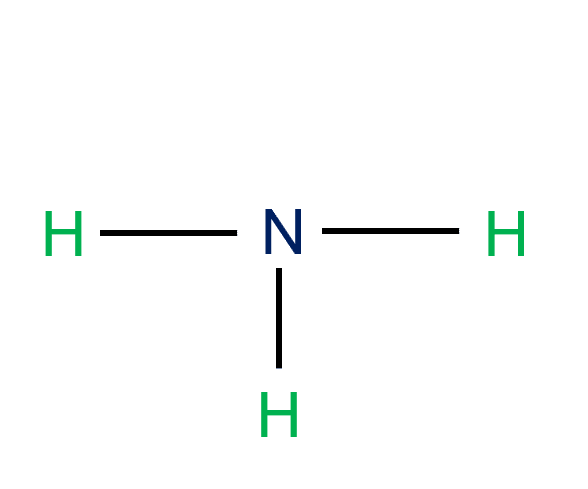
Step-2: Determine the Central Atom
As per the rule, N is placed in the middle because it has the maximum number of valence electrons, which is five. Hydrogen has only one valence electron.
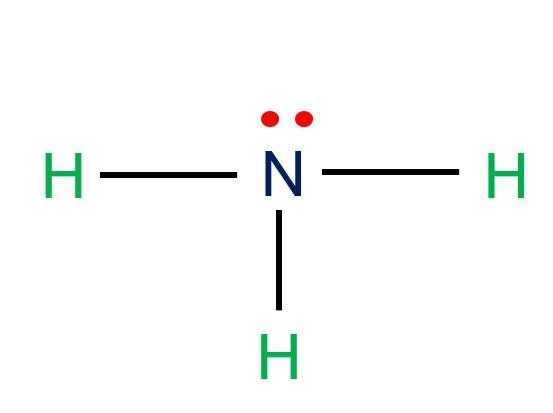
Step-3: Place Electron Pairs Between the Atoms
We need to distribute the 8 valence electrons.
In the figure, one electron pair between two atoms is equivalent to one line. Out of eight electrons, six will be used in pairs between atoms. Now we have 2 valence electrons to distribute. In the ammonia Lewis structure, the hydrogen atoms are the outside atoms, and each one of them cannot keep more than two electrons in its last shell. Therefore, we will draw the remaining electron pair on the central nitrogen atom.
Electronic Configuration of Nitrogen in Ammonia
- Nitrogen in its ground state has the configuration 1S22S22P3.
- During hybridization, one s orbital and 3p orbitals hybridize to form four hybrid orbitals of equal energy levels, making SP3 hybridization.
- Three half-filled SP3 orbitals of nitrogen form a bond with three hydrogen atoms.
- The fourth full-filled hybridized orbital holds the lone pair of electrons.
- The trigonal structure of ammonia is due to repulsive lone pair-bond pair attraction.
- As a result, the bond angle in the ammonia is 107o which is less than the standard 109.5o.
What is a Lone Pair of the Electron?
A lone pair of electrons refers to a pair of electrons that exist without bonding or sharing with other atoms.
A lone pair attracts one nucleus.
Therefore, it adopts a position effectively closer to that one nucleus than the bonding pairs of electrons.
In addition, the lone pair demands a greater angular range.
For instance, in ammonia, the lone pair makes room for itself by pushing the three hydrogen atoms together a little, and the H-N-H bond angles are slightly less (106.6°) than the ideal tetrahedral angle of 109.5°.
What is meant by Lewis structure?
The Lewis structure, also referred to as the electron-dot structure, is a structural formula in which electrons are represented by dots; two dots between two atoms represent a covalent bond. To draw the Lewis structure, we place a dot around the atom for each valence electron available.
Importance of Lewis Structure
Lewis structures are very important for predicting the geometry, polarity, and reactivity of (in)organic compounds.
Rules for drawing Lewis dot structures
- Choose a central atom (least electronegative atom)
- Draw the molecular skeleton.
- Count all the valence electrons.
- Draw a single bond from each surrounding atom to the central atom.
- Subtract 2 valence electrons for each bond.
- Distribute the remaining electrons as lone electron pairs to maximize the number of octets.
- If some of the atoms lack octet structures, change as many lone electron pairs into shared electron pairs as required to complete the octet shells.
Octet rule
The octet rule states that in forming compounds, atoms tend to gain a stable electron configuration, the electron configuration of the nearest noble gas (8 valence electrons except for He with 2). When atoms have fewer than eight electrons, they tend to react and form more stable compounds.
Limitations of Octet Rule
- The distribution of electrons as bonding or lone pairs is not possible in species having an odd number of electrons, such as nitrogen oxide (e.g., NO, NO2) and neutral methyl.
- When there are too few electrons to form an octet, electron deficiency occurs. For example, BF3, with only 6 electrons in its bonding pairs
- Atoms with shells 3 and higher can expand their outer shell to form more than four bonds.
NH3 Lewis Structure- Key Points
- Ammonia is a colorless gas.
- It is easily liquefied due to the strong hydrogen bonding between molecules.
- Pungent odor.
- The ammonia molecule exhibits a trigonal pyramidal shape.
- The melting point is -77.73°C.
- The boiling point is -33.34 °C.
- The density is 0.73 kg/m3.
- The molar mass of ammonia is 17.03052 g/mol.
- classified as an extremely hazardous substance.
- It is used as a raw material to make a variety of commercially significant nitrogen compounds.
What is Ammonia?
Ammonia also referred to as hydrogen nitride, is a compound of nitrogen and hydrogen.
It is produced artificially by reacting natural gas, namely methane, with steam to form hydrogen in the primary reformer. In the secondary reformer, the air is added to the gas stream. In the converter, the remaining hydrogen and the nitrogen from the air combine in a ratio of 3:1 to produce ammonia. The uncombined gases are recycled back to the converter.
Molecular Geometry of NH3
NH3 molecular geometry is trigonal-pyramidal. The reason for this is that the nitrogen atom has a single non-bonding lone pair of electrons that serve as a repulsive force on the bonding orbitals.
The three hydrogen atoms are bonded to a nitrogen atom in the middle.
Since nitrogen has 5 electrons in its valence shell, it must interact with 3 hydrogen atoms to satisfy the octet rule and produce ammonia, a stable molecule.
Molar Mass of Ammonia
Molar mass of Nitrogen = 14.0067 g/mol.
The hydrogen molar mass is 1.00794 g/mol.
Molar mass of Ammonia (NH3)= 14.0067 g/mol + (3× 1.00794) g/mol = 17.03052 g/mol
= 17.03052 g/mol
Is Ammonia is a strong base?
Ammonia is a weak base. It itself doesn’t contain hydroxide ions, but it reacts with water to produce ammonium ions and hydroxide ions. A weak base is a base that does not completely dissociate into its constituent ions when dissolved in solutions.

Uses of Ammonia
- Ammonia is used in the manufacture of explosives.
- dye-making.
- preparing medicines.
- used in the production of fertilizers.
- Ammonia is also used in household cleaning products.
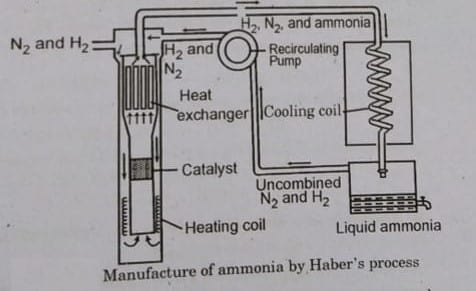
Haber Process
Most of the commercial ammonia is obtained by Haber’s process.
In this process, 1 volume of nitrogen and 3 volumes of hydrogen of purified gases are mixed.
The mixed reactants are then compressed to 200–500 atm pressure by special pumps, injected into the heated reaction vessel, and then passed over the catalyst consisting of a mixture of Fe with a little Molybdenum (Mo) maintained at 400–500 °C.
The emerging reaction mixture (containing about 10% ammonia) is removed perpendicularly by liquefaction. The unreacted nitrogen and hydrogen are recycled. Excess nitrogen is used to favor the reaction to the right.
Haber Process Equation
N2 (gas) +3H2 (gas) → 2NH3(gas).
The chemical reaction between N2 and H2 is exothermic, reversible, and spontaneous. According to the Lechatlier principle, high pressure and low temperature are favorable conditions for the high yield of ammonia.
NH3 Polar Nature
The NH3 molecule is polar. The electronegativity difference between N (3.04) and H ((2.2) makes the N–H bond polar. The difference in their electronegativities causes three dipole moments from the three N-H bonds in one direction.
The three dipoles in one direction form a net dipole moment that makes it a polar molecule.
In addition, the lone pair on the nitrogen atom exerts an outward force on the bond due to which the shape of NH3 becomes unsymmetrical.
Summary
- Ammonia has a trigonal structure.
- Many industries use the Haber process to produce ammonia on an industrial scale.
- Some well-known uses of ammonia are dye-making, preparing medicines, and production of fertilizers.
- NH3 Lewis structure shows that there are three N-H bonds and one lone pair
Related Topics
CO2 Lewis Structure and Molecular Geometry
HCN Lewis Structure| Step By Step Construction
SiO2 Lewis Structure
N2O Lewis Structure| Laughing Gas
Charge of Ammonia (NH3)| Simple Steps
Frequently Asked Questions (FAQs)
Below are some of the frequently asked questions
1. What is the oxidation number of NH3?
Ammonia is made up of one nitrogen atom and three hydrogen atoms (NH3). The NH3 oxidation number is zero because the sum of the individual oxidation values of the atoms nitrogen (oxidation number =-3) and hydrogen (oxidation number =1) is zero.
3. What is CLF3 molecular geometry?
CLF3 has a T-shaped molecular geometry and trigonal bipyramidal electron geometry. According to the ClF3 Lewis structure, this molecule has two lone pairs and three bound pairs. ClF3 is a polar compound.
Exposure to 300 ppm is dangerous to life and health (IDLH) and can be fatal within a few breaths. Ammonia is corrosive to the skin, eyes, and lungs.
NH3 (ammonia) is a toxic gas.
Ammonium is a nontoxic salt. It is the ionized form of ammonia.
Its ions are produced during ammonification.
Ammonia can irritate the respiratory tract and can cause coughing and shortness of breath. Its inhalation can also cause nose and throat irritation.
Ammonia consists of one negatively charged nitrogen ion and three positively charged hydrogen ions. The pH of standard ammonia is about 11.
Bottom Line
This article explains the steps to draw the Ammonia Lewis structure, the molecular geometry and arrangement of atoms in NH3, the definition of Lewis structure, and the definition of lone pair of electrons. Please feel free to comment if you have any questions.
More Interesting Topics
Author
Ms. Sana Javed
Sana has been working at Whatsinsight since 2020 as a content writer.
She has an MPhil degree in pharmaceutics.
- BCl3 Lewis Structure in four simple steps - November 1, 2023
- PH3 Lewis Structure in four simple steps - October 8, 2023
- PF3 Lewis structure in four simple steps - September 24, 2023


